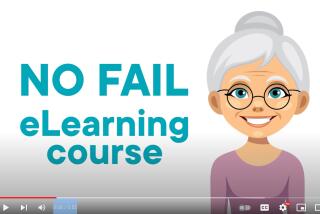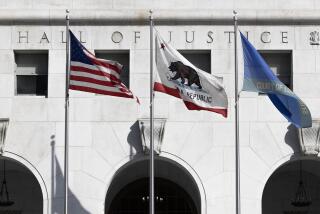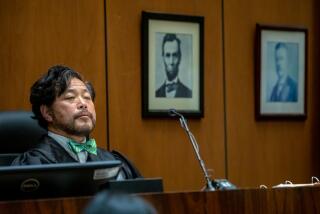DMV’s Antiquated Records Retard Probe of Bribery Allegation
The state Department of Motor Vehicles cannot quickly or easily assess the performance of its license hearing officers because of a record-keeping system that still relies heavily on typed or handwritten logbooks, according to department officials.
The antiquated system may have delayed the detection of the misconduct of a former Long Beach hearing officer who has admitted taking bribes of money and sex in exchange for allowing problem drivers to keep their licenses, said several sources familiar with the case.
Michael R. Tarrish, 47, who was dismissed by the department last Tuesday, told The Times that he had accepted an outright bribe of $300 from a lawyer and sex from a woman who appeared before him, in exchange for favorable rulings in two cases.
Tarrish also has said that he handled about 50 other hearings for motorists whose attorneys had loaned him money last year. The money--about $2,000--was never repaid. Tarrish acknowledged that his decisions in those cases at least appeared to favor the attorneys’ clients.
Tarrish, whose job title was principal driver safety analyst, is under investigation by agents of the department’s special operations unit. The head of the unit, Julie C. Mansfield, said she expects to present evidence against him to the Los Angeles County district attorney’s office by the end of the month. The district attorney must then decide whether to file criminal charges.
DMV officials looking into the allegations against Tarrish were forced to spend weeks poring over typed and handwritten records kept at the Long Beach office to determine the outcomes of the hearings conducted by Tarrish and to identify the attorneys who represented motorists who appeared before him.
Without commenting on the Tarrish investigation, James Dunn, who coordinates the department’s driver safety program out of Sacramento, said that any DMV manager seeking to evaluate a body of decisions made by a hearing officer would be required to undertake the same laborious task.
“He . . . would have to look at that (the logbooks at the district office),” Dunn said. “That could be a problem. Also, it would be impossible to compare (that analyst) with other analysts throughout the state. You still would not have an idea of how that person compares to the guy in Northern California, if you’re down in Long Beach.”
Hearing results currently are recorded in the DMV’s computerized data base only under the names of the affected drivers. The name of the hearing officer who handled the case or that of the attorney who represented the motorist is not listed in those records.
The DMV is upgrading the type and quantity of hearing information available on its central computer, Dunn added, but the project will not be completed for perhaps another year. In addition, Dunn said, he hopes to install personal computers in each district office to allow local managers to keep closer track of scheduling and hearing decisions.
“This will give you another safeguard in that district office,” Dunn said.
One source familiar with the investigation of Tarrish said the DMV’s examination of his hearings indicated that he was far more lenient than his fellow analysts in setting aside license suspensions and revocations.
“He was giving things away,” another source said. Had a computerized case tracking system been in place, Tarrish’s activities might have been spotted earlier, the source said.
The investigation of Tarrish began in early September, after a citizen complained to the department, an official said last week.
The Times has learned that Tarrish himself was responsible for scheduling driver safety hearings in the Long Beach office during the 18-month period that ended in early November. That allowed him to choose the cases he would hear.
The DMV driver safety section employs 137 hearing officers, who are known in the department as analysts or referees, working out of 22 offices throughout the state. All but five of the driver safety offices are quartered in buildings that also house drivers’ license and auto registration field offices.
The safety analysts have broad authority under the California Vehicle Code to sustain, set aside or amend the department’s decisions to suspend or revoke the right to drive or to place errant motorists on probation. California has nearly 18 million licensed drivers.
Most of the safety analysts’ work involves hearings held under the DMV’s point system, which flags drivers who have accumulated too many traffic citations or who have been involved in too many accidents.
In the year that ended last June 30, for example, the department took action against 70,994 drivers whose infractions had earned them four points in a 12-month period. (A speeding ticket, for example, generally adds one point to a driver’s record.) Of the total, 51,523 drivers requested hearings before driver safety analysts, and all but about 2,000 showed up at the appointed time.
The analysts conducted another 3,598 hearings under a related program that gives the department the right to suspend or revoke the licenses of drivers who have been involved in certain incidents involving alcohol and automobiles.
Analysts conducted another 8,127 hearings for motorists who either failed or refused to take blood, breath or urine tests for alcohol after they were stopped by police.
In addition to presiding at the hearings, safety analysts conducted more than 35,000 re-examinations of motorists who had been referred to the department by physicians, hospitals, relatives or law enforcement agencies because of medical problems such as diabetes or epilepsy; chronic alcohol or drug addiction, or failure to demonstrate adequate driving skills.
Until 1981, all decisions made by safety analysts were reviewed by their superiors in Sacramento. The state Legislature changed that system, apparently in response to complaints about delays it created. Now, only decisions made in so-called formal hearings--where sworn testimony is taken--are routinely examined by a higher-up. The bulk of driver safety cases are decided in informal proceedings, Dunn said.
More to Read
Sign up for Essential California
The most important California stories and recommendations in your inbox every morning.
You may occasionally receive promotional content from the Los Angeles Times.










